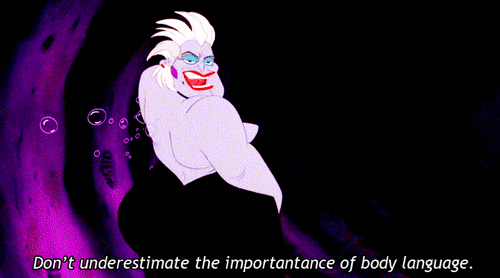Tutors, we’ve all been there: you’re sitting by your writer, in awkward silence. You try to think of ways to build rapport, but there isn’t much to talk about besides the weather or how many (or little) hours of sleep you’re getting this week–and you guys have already talked about those! So how do you break out of small-talk limbo when both parties have exhausted all “things to talk about with a complete stranger” options?
What if I told you that there’s a way to not only build rapport, but build it throughout your appointment without saying a word? Sounds unbelievable, right? Just as unbelievable as those pop-up ads about the woman dermatologists hate because of five crazy tricks?
Well, here are three crazy tricks to building rapport and effective communication with your writer:
1) Maintain eye contact

Eye contact is a great way to open communication with your writer, as eye contact can say a lot about your personality, disposition, and even about your honesty! As our good friend Christopher Walken said: “the eyes are the windows to your face”. When approaching your writer at the beginning of your appointment, establish eye contact before you greet them, ideally three to four seconds prior. As for the rest of the appointment, try maintaining eye contact at least 50% of the time when speaking and around 70% of the time while listening. But be sure not to stare: it communicates hostility and is usually perceived as a threat (and it’s just plain creepy). How you maintain eye contact with your writer affects them — so keep this in mind!
2) Read their body language

Believe it or not, we don’t communicate verbally as often as you think. In fact, 14 percent of our daily communication is verbal, whereas 79 percent is all body language. When discussing with your writer the agenda for the appointment or pointing out a grammatical mistake, make note of how they react or are sitting (which should be easy if you’re following step one). There are many indicators of whether or not your writer may be engaged in the appointment. Palms flat on table and frequent smiles from them is a sure indicator that they are receptive to what you are expressing and are actively listening. What if their head is resting on their palm with a blank stare on their face? That’s a red flag right there. So how do you get your writer to be more engaged?
3) Mirror them

This is exactly what you think it is: mirror your writer! An effective way to build rapport, or to increase a person’s comfort when they are resistant, is to utilize this technique. Start by observing their body posture and then subtly letting your body reflect their position. If their arms are crossed, then slowly begin to cross your arms. If they lean back, you do the same. You will know that you have developed mutual rapport if your writer begins to mirror you in return. Change your arm position and see if they match your movement into the new posture. Mirroring the writer’s actions not only simulates them, but it also communicates feelings and intentions!
Now that you’ve read about these three tips and tricks to proper body communication, you should be a pro at rapport building now! Totally kidding: these tips are just some cool suggestions for how you could work on your rapport building. What’s also neat about this is that anyone can utilize these neat techniques in their daily life — you don’t have to be a tutor or in an appointment! Use them on your parents, your friends, or your little furry (or scaly, I don’t judge) friends: go wild!

